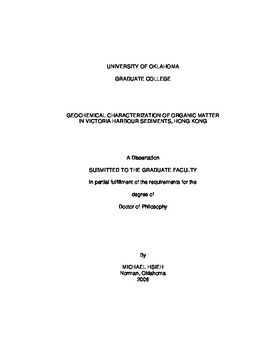| dc.contributor.advisor | Philip, Richard P., | en_US |
| dc.contributor.author | Hsieh, Michael. | en_US |
| dc.date.accessioned | 2013-08-16T12:20:03Z | |
| dc.date.available | 2013-08-16T12:20:03Z | |
| dc.date.issued | 2006 | en_US |
| dc.identifier.uri | https://hdl.handle.net/11244/988 | |
| dc.description.abstract | The organic carbon-to-nitrogen ratio demonstrated fluctuations in the sources of organic matter throughout the Holocene unit of MBH 54/2. High fluxes in the carbon-to-nitrogen ratio may reflect strong storms, where excess terrigenous plant material is transported into the area. Sediment intervals impacted by sewage waste had isotopic compositions (i.e., delta 13Corg and delta15N) consistent with those reported in the literature for sewage in coastal environments. | en_US |
| dc.description.abstract | Sources of organic matter could be differentiated using free lipids, which consisted of sterols, n-alcohols, fatty acids, and n-alkanes. Environmental conditions in Kowloon Bay were inferred to be anoxic based on the relative abundance of stanols-to-sterols. Sewage contaminated sediments were confirmed by the presence of fecal sterols. Periods of improved environmental conditions were noted by the occurrence of sterols common to aquatic organisms. Bound lipids appear to retain lipid profiles descriptive of bacterial communities in the sediments. More in-depth comparisons to lipid profiles of bacterial strains might allow bacterial remnants in sediments to be identified, allowing us to better speculate on their role in the remineralization of organic matter in Recent sediments. | en_US |
| dc.description.abstract | Victoria Harbour is located between Kowloon and Hong Kong Island in the southeastern prodelta region of the Pearl River system. Since the mid-1900s, the population in Hong Kong has grown rapidly, coastal areas surrounding Victoria Harbour have been reclaimed, and excess raw sewage has been disposed into the Harbour. Release of methane from harbour sediments during dredging activities instigated interest in studying the sources of methane trapped in Victoria Harbour sediments. Core MBH 54/2, from a heavily polluted area in Victoria Harbour's Kowloon Bay, was selected for this study. However, no methane was detected in sediments from this core. The project was redefined, using a detailed organic geochemical characterization approach to determine the sources of organic matter, evaluate changes in environmental conditions, and to ascertain whether remnants of bacterial lipids might be present to enhance our understanding of processes contributing to methane generation. Bulk properties (e.g., %Corg, %N, delta 13Corg, and delta15N), lipid composition and profiles were applied to delineate changes in organic matter sources deposited in the Kowloon Bay area during the late Quaternary. | en_US |
| dc.format.extent | xix, 206 leaves : | en_US |
| dc.subject | Sewage disposal in the ocean China Victoria Harbor. | en_US |
| dc.subject | Harbors China Hong Kong. | en_US |
| dc.subject | Physical Oceanography. | en_US |
| dc.subject | Geochemistry. | en_US |
| dc.subject | Engineering, Sanitary and Municipal. | en_US |
| dc.subject | Marine sediments China Victoria Harbor. | en_US |
| dc.title | Geochemical characterization of organic matter in Victoria Harbour sediments, Hong Kong. | en_US |
| dc.type | Thesis | en_US |
| dc.thesis.degree | Ph.D. | en_US |
| dc.thesis.degreeDiscipline | Conoco Phillips School of Geology and Geophysics | en_US |
| dc.note | Source: Dissertation Abstracts International, Volume: 67-01, Section: B, page: 0143. | en_US |
| dc.note | Adviser: Richard P. Philip. | en_US |
| ou.identifier | (UMI)AAI3207060 | en_US |
| ou.group | Mewbourne College of Earth and Energy::Conoco Phillips School of Geology and Geophysics | |
